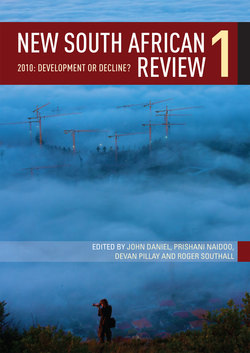Читать книгу New South African Review 1 - Anthony Butler - Страница 10
На сайте Литреса книга снята с продажи.
Employment, unemployment and inequality
ОглавлениеThere is little point in belabouring the well known fact that the post-apartheid economy is characterised by a crisis of unemployment. Debate continues about the contribution made towards this by the post-apartheid labour regime, which through the Labour Relations Act of 1995 and the Basic Conditions of Employment Act of 1997 provides significant protections for formally employed labour. Concession to this regime was crucial to incorporating Cosatu into the transitional deal, but a standard criticism of many commentators is that it has unduly privileged organised labour, acts as a major disincentive to employment creation (particularly by small business) and has encouraged employers to duck regulation by shifting towards ‘flexible’ employment patterns. Even so, deeper structural and technological changes have encouraged greater capital intensity which, in combination with the legacy of apartheid policies in education (and a failure to address it), has forged a labour market which remains heavily segmented along racial lines and which displays socially disastrous levels of unemployment. Unemployment is particularly high amongst the unskilled, and disproportionately affects the African population (McCord and Bhorat 2003: 113; Webster and von Holdt 2005). As explored by Makgetla below, these broad patterns have been exacerbated by the impact of the present global crisis upon the South African economy, which in 2009 resulted in the loss of nearly one million jobs.
Even if these job losses were to be reasonably rapidly reversed, this would be totally inadequate for addressing long-term employment needs. A study by a working group convened from representatives of government, business and labour, orchestrated by Miriam Altman of the Human Sciences Research Council, indicates that even if unemployment were to be halved to 13 per cent, by 2014 (the target set by the government), 35 per cent of the population would continue to live below the poverty line of R2 500 a month unless they were to be rescued by receipt of social grants. This reflects the fact that not only are wages for unskilled workers low, relative to the cost of living, but wage earners in poor households support, on average, six people. Yet even this scenario rests upon attainment of an average 6 per cent growth rate between 2004 and 2014, a goal which is highly unlikely to be achieved. More likely are lower growth scenarios which will see a rise in the proportion of the ‘working poor’ and those living in poverty.
In many African countries, the poor and unemployed can draw support from agriculture. In South Africa, however, African peasant production was long ago destroyed by the appetites of the mines for labour and of settler agriculture for land, and today the former homeland areas are agriculturally devastated, land reform has stalled3 and rural African communities are heavily reliant on financial inputs from urban areas. In practice, this has substantially increased pressure on the post-apartheid state to expand its financial support not merely for the unemployed but for the poor generally through an array of social benefits ranging from old age pensions to disability grants. As a result, while the aspirations of South Africa to become a ‘welfare state’, inclusive of contemporary proposals for a national health system (Reynolds below), are morally commendable, there are numerous questions regarding the extent to which they are affordable over the long-term.4 Critics point out that the growth in numbers of grant recipients (13.9 million in 2010 rising to sixteen million by 2013) is not matched by a similar increase in the number of direct taxpayers (six million) (Business Report, 22 February 2010).
The immediate answer to unemployment, argues Altman, is an expansion of the public service, recording a shift towards the hiring of teachers, nurses, and police as well as, importantly, entry level workers. Increasing the number of publicly funded low-skilled jobs would make the most immediate impact upon the level of unemployment, yet because low-skilled public sector workers earn twice to three times more than they are paid in the private sector, the government cannot afford to hire them at present pay levels, and it is not likely that public sector unions will easily accept the idea of a reduced wage, even for new job entrants. Even more problematic is the fact that, ‘While the size of the public service has been growing in recent years, its capacity to do its job hasn’t’ (Paton 2007:43).
If the crisis of unemployment appears recalcitrant, its social impact is made worse by the extent and nature of social inequality. In 2008, while the richest 10 per cent of the population received 53.1 per cent of income and the richest 20 per cent received 70 per cent of total national incomes, the poorest 10 per cent received just 0.57 per cent and the poorest 20 per cent just 1.6 per cent (RSA 2009: 22). These proportions have not changed significantly since the early 1990s, despite some modest shift of the overall proportion of national income going to blacks,5 demonstrating the deeply structural nature not just of poverty but of the inequality of distribution. Politically, its impact is severely worsened by three features of the contemporary scene; first, the alacrity with which corporate executives in both the private and parastatal sectors have fastened on to global trends in ‘top people’s’ remuneration, claiming massive benefits in terms of share options, retainers, bonuses and restraint of trade agreements on top of huge salaries; second, the apparently insatiable greed of elements of the new black elite, and the entrenchment of a culture of entitlement based upon corrupt access to state tenders; and third, the preference of South African elites for highly conspicuous consumption in terms of extravagant lifestyles, clothing, cars, mansions and ‘bling’ (all of which is stoked by the popular media’s obsession with celebrity).
